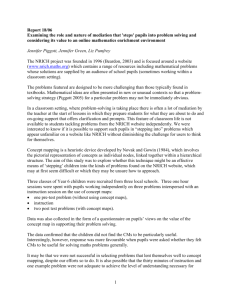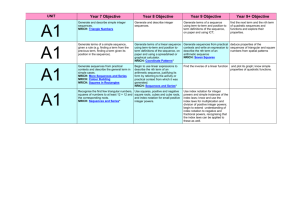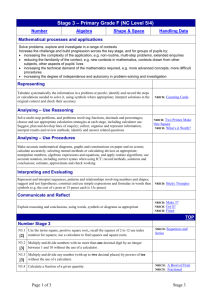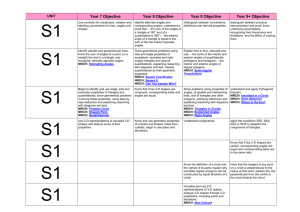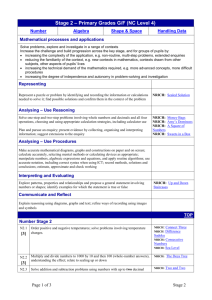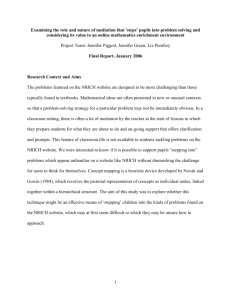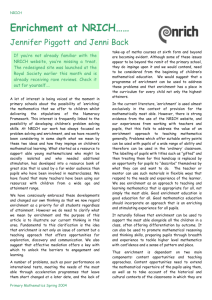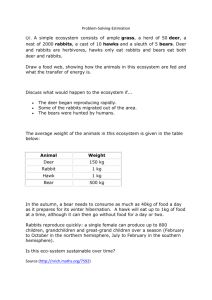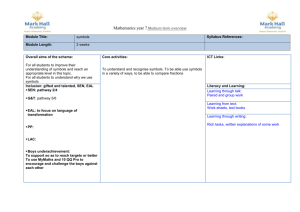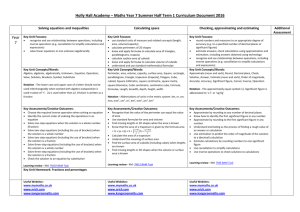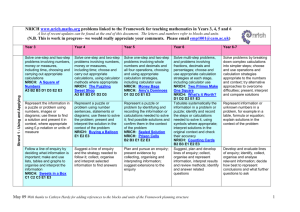Stage 1
advertisement
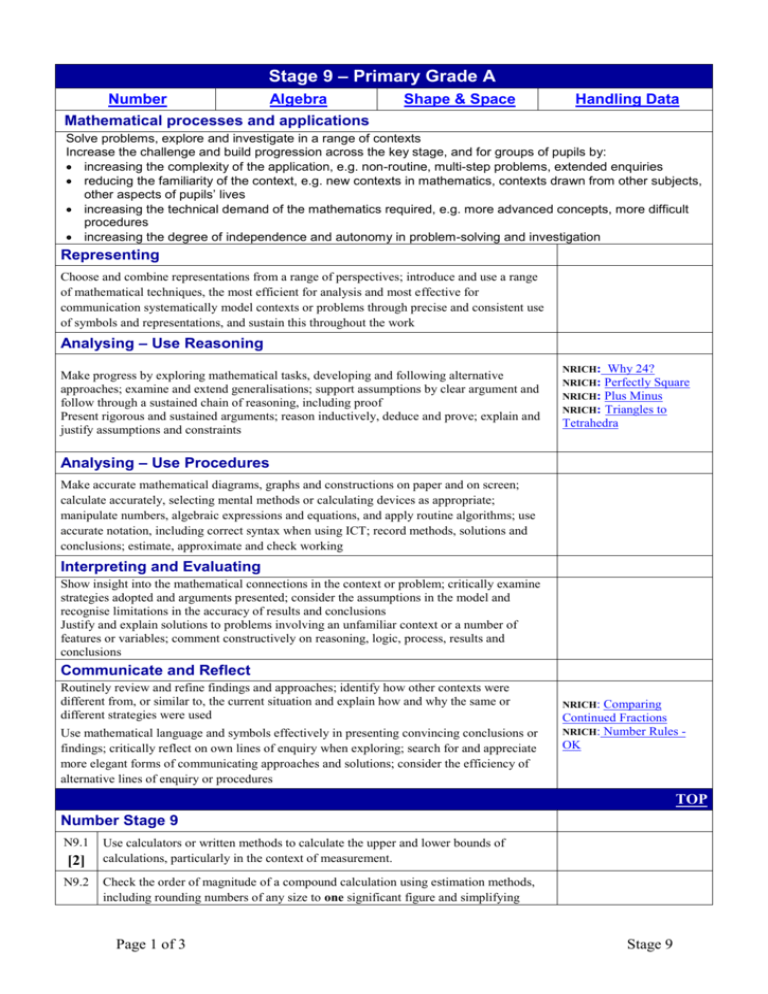
Stage 9 – Primary Grade A Number Algebra Shape & Space Handling Data Mathematical processes and applications Solve problems, explore and investigate in a range of contexts Increase the challenge and build progression across the key stage, and for groups of pupils by: increasing the complexity of the application, e.g. non-routine, multi-step problems, extended enquiries reducing the familiarity of the context, e.g. new contexts in mathematics, contexts drawn from other subjects, other aspects of pupils’ lives increasing the technical demand of the mathematics required, e.g. more advanced concepts, more difficult procedures increasing the degree of independence and autonomy in problem-solving and investigation Representing Choose and combine representations from a range of perspectives; introduce and use a range of mathematical techniques, the most efficient for analysis and most effective for communication systematically model contexts or problems through precise and consistent use of symbols and representations, and sustain this throughout the work Analysing – Use Reasoning Make progress by exploring mathematical tasks, developing and following alternative approaches; examine and extend generalisations; support assumptions by clear argument and follow through a sustained chain of reasoning, including proof Present rigorous and sustained arguments; reason inductively, deduce and prove; explain and justify assumptions and constraints NRICH: NRICH: NRICH: NRICH: Why 24? Perfectly Square Plus Minus Triangles to Tetrahedra Analysing – Use Procedures Make accurate mathematical diagrams, graphs and constructions on paper and on screen; calculate accurately, selecting mental methods or calculating devices as appropriate; manipulate numbers, algebraic expressions and equations, and apply routine algorithms; use accurate notation, including correct syntax when using ICT; record methods, solutions and conclusions; estimate, approximate and check working Interpreting and Evaluating Show insight into the mathematical connections in the context or problem; critically examine strategies adopted and arguments presented; consider the assumptions in the model and recognise limitations in the accuracy of results and conclusions Justify and explain solutions to problems involving an unfamiliar context or a number of features or variables; comment constructively on reasoning, logic, process, results and conclusions Communicate and Reflect Routinely review and refine findings and approaches; identify how other contexts were different from, or similar to, the current situation and explain how and why the same or different strategies were used Use mathematical language and symbols effectively in presenting convincing conclusions or findings; critically reflect on own lines of enquiry when exploring; search for and appreciate more elegant forms of communicating approaches and solutions; consider the efficiency of alternative lines of enquiry or procedures NRICH: Comparing Continued Fractions NRICH: Number Rules OK TOP Number Stage 9 N9.1 [2] N9.2 Use calculators or written methods to calculate the upper and lower bounds of calculations, particularly in the context of measurement. Check the order of magnitude of a compound calculation using estimation methods, including rounding numbers of any size to one significant figure and simplifying Page 1 of 3 Stage 9 [2] calculations using standard index form, without the use of a calculator. N9.3 Use fractional, negative and zero powers in simplifying numerical expressions, including using inverse operations. [2] NRICH: NRICH: NRICH: Big Powers Negative Power Napier's Location Arithmetic TOP Algebra Stage 9 A9.1 Rearrange harder formulae, including cases where the subject appears twice, or where [4] a power of the subject appears. NRICH: NRICH: NRICH: For What? Why 24? Perfectly Square A9.2 Form and use equations to solve word and other problems involving direct or Inverse [5] proportion (for example, y x, y x², y 1/x, y 1/x²) including relating algebraic solutions to graphical representations of the equations. NRICH: A9.3 Manipulate algebraic expressions by expanding the product of two linear expressions, [5] by taking out common factors and by cancelling common factors in rational expressions; factorise quadratic expressions, including the difference of two squares; solve quadratic equations of the form ax2 + bx + c = 0 by factorisation. NRICH: Always Perfect A9.4 Find gradients of straight lines perpendicular to each other and write equations of [2] straight lines in the form y = mx + c. NRICH: Perpendicular Mathematics of Yesteryear NRICH: Rule of Three NRICH: Reza's Age Lines TOP Shape Stage 9 S9.1 [2] S9.2 [4] S9.3 [5] S9.4 [3] S9.5 [3] Shape Resources Use and prove angle and tangent properties of circles, including the alternate segment theorem. NRICH: Circle-in Use Pythagoras’ theorem and trigonometrical relationships in 3-D contexts, including using 3-D coordinates and finding the angles between a line and a plane; use Pythagoras’ theorem to find the length AB given the points A and B in 2-D. NRICH: NRICH: Semi-detached The Spider and the Solve problems involving the lengths of arcs, areas of sectors and the volume of pyramids, cones and spheres. NRICH: Fly Litov’s Mean Value Theorem NRICH: Semi-detached NRICH: Shaded Circles NRICH: Base Ratios NRICH: Triangles and Petals NRICH: Cola Can NRICH: Funnel Understand and use the effect of enlargement on length, area and volume of shapes and solids, including the use of negative scale factors. Understand and use speed, velocity and acceleration calculations NRICH: One and Three TOP Data Stage 9 D9.1 Modelling with data [1] NRICH: Epidemic Modelling D9.2 Solve structured problems involving the addition or multiplication of two Page 2 of 3 Stage 9 [3] probabilities. D9.3 Draw and interpret histograms for grouped data; understand frequency density. [4] D9.4 Select a representative sample from a population using random and stratified sampling; [1] criticize sampling methods. TOP Page 3 of 3 Stage 9
